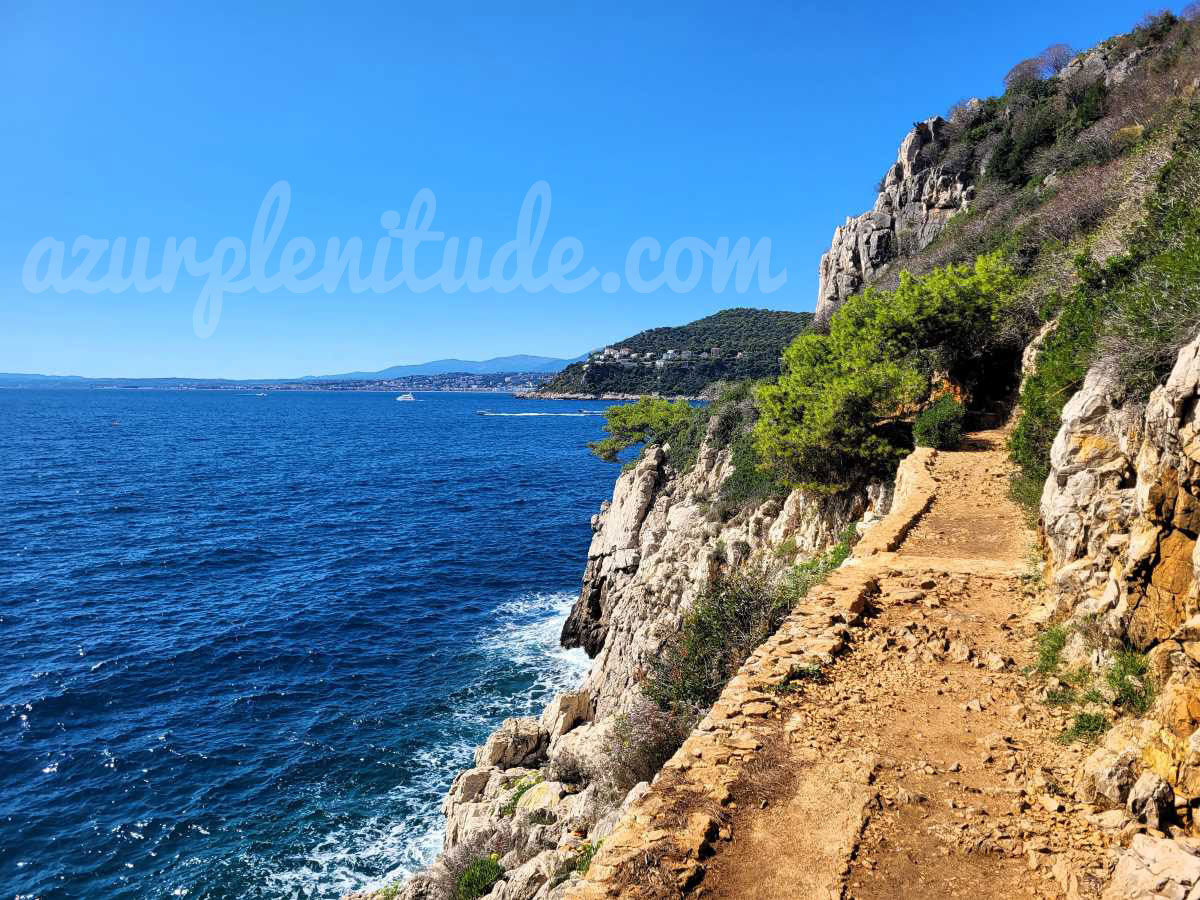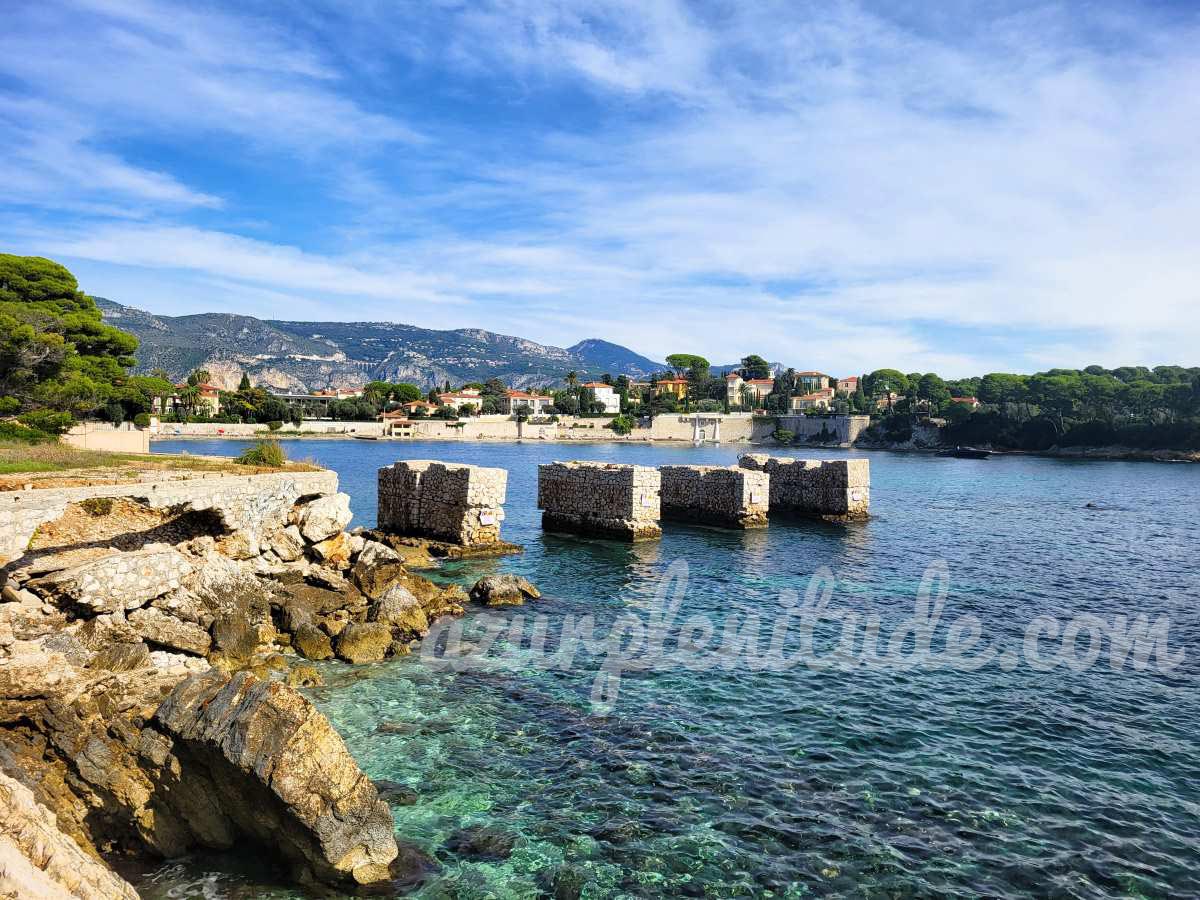Chemin des Douaniers in Saint-Jean-Cap-Ferrat
The coastal path of the Douaniers in Saint-Jean-Cap-Ferrat offers a stunning seaside stroll. Spanning over 4 kilometers, the trail follows the coastline of Cap-Ferrat, one of the best-preserved gems of the French Riviera. With no significant difficulty, this route allows you to explore hidden little coves, perfect for a peaceful swim. Finally, you will have the opportunity to admire several points of interest, such as the “COEXIST” fountain and the lighthouse of Cap-Ferrat.
Hiking features
- Distance : 8.6 km
- Estimated duration : 2h
- Difficulty : Medium
- Elevation gain : + 29m / - 29m
- Parking nearby
- Pets allowed
- Swimming areas
- Walking shoes recommended
A beautiful trail running along the coastline of Cap-Ferrat

The first section of the route extends from Passable Beach to the Cap-Ferrat lighthouse. Narrow and punctuated by small stairs, it offers breathtaking views of the bay of Villefranche-sur-Mer. Below, small coves with crystal-clear waters are revealed, ideal for a peaceful swim. The trail, although not stabilized, poses no significant difficulty. However, it is not suitable for strollers or people with reduced mobility.

As you approach the tip of the Cap, the landscape opens up, and the coves give way to vast rocky expanses. These contrast with the deep blue of the Mediterranean and the pine forests that dominate the trail. This section of the route is accessible to everyone, as the path is relatively flat and stabilized. Ultimately, the hike leads to Anse des Fosses, a beautiful bay with clear waters where the Fosses Beach is nestled.
Small Wild Coves for a Peaceful Swim

In addition to its breathtaking landscapes, the coastal trail provides the opportunity to swim in an idyllic setting. Indeed, the route between Passable Beach and the lighthouse is dotted with discreet and preserved coves.

Down below the path, small wild beaches with clear waters await you. Often accessible by small staircases, these little pieces of paradise are perfect for swimming and exploring the underwater world. For sunbathers, there is a platform by the water on Gavinette Beach, ideal for laying out a towel in the sun.

Points of Interest Along the Customs Path
In addition to the stunning coastal landscapes and secluded swimming spots, the Customs Path offers several points of interest. Here are some of the attractions you can encounter along the way.
The Cap-Ferrat Lighthouse

Located midway along the route, at the tip of the Cap, the Cap-Ferrat lighthouse stands facing the vastness of the sea. This octagonal masonry tower is built on the site of the former Villefranche lighthouse, which was destroyed by the Germans during World War II in 1944.
The COEXIST Fountain
At the junction between the access to the lighthouse and the continuation of the path, a small fountain bearing the inscription “COEXIST” catches the eye. This name refers to the association that inaugurated it in 2007. The fountain features the Muslim crescent, the Jewish Star of David, and the Christian cross, which together form the letters of the inscription. It is a symbol intended to represent peace and dialogue among these different religions. Many walkers take advantage of this water point to hydrate and take a short break.
The Grand Hotel du Cap-Ferrat
The Grand Hotel du Cap-Ferrat is an essential address on the Côte d’Azur. Inaugurated over a century ago, this splendid hotel reflects the luxury and elegance of the Riviera. From the path, you can glimpse the lovely terraces of the hotel nestled in the pine forest. You can also see a rail with a small wagon, which helps the staff facilitate service to these outdoor spaces.
The Remains of the Former Quarry of Saint-Jean-Cap-Ferrat

As you approach the Anse des Fosses, the space around the path widens. It is here that the former quarry of Saint-Jean-Cap-Ferrat reveals itself, recognizable by the hillside whose slopes have been excavated. In this location, four blocks of stone and cement emerge from the water. Built in 1901, there were originally seven of these blocks. They were used to support a dock from which the rock extracted from the hillside was loaded onto boats. The stones were then transported by sea to Monaco to be used in the construction of the jetty at Port Hercule. The quarrying ended in 1920. Today, only four of these pillars remain, serving as a testament to the industrial past of this site.
Route and Access to the Start of the Chemin des Douaniers
In Conclusion
The Coastal Path at Saint-Jean-Cap-Ferrat offers an opportunity to explore one of the best-preserved coastlines of the French Riviera. You will discover small, hidden coves that are perfect for swimming in tranquility. Along the route, several other attractions, such as the Cap-Ferrat Lighthouse and the “COEXIST” fountain, await your visit. Overall, the trail is accessible to all, although some narrow stairs may make it challenging for strollers and individuals with reduced mobility.

